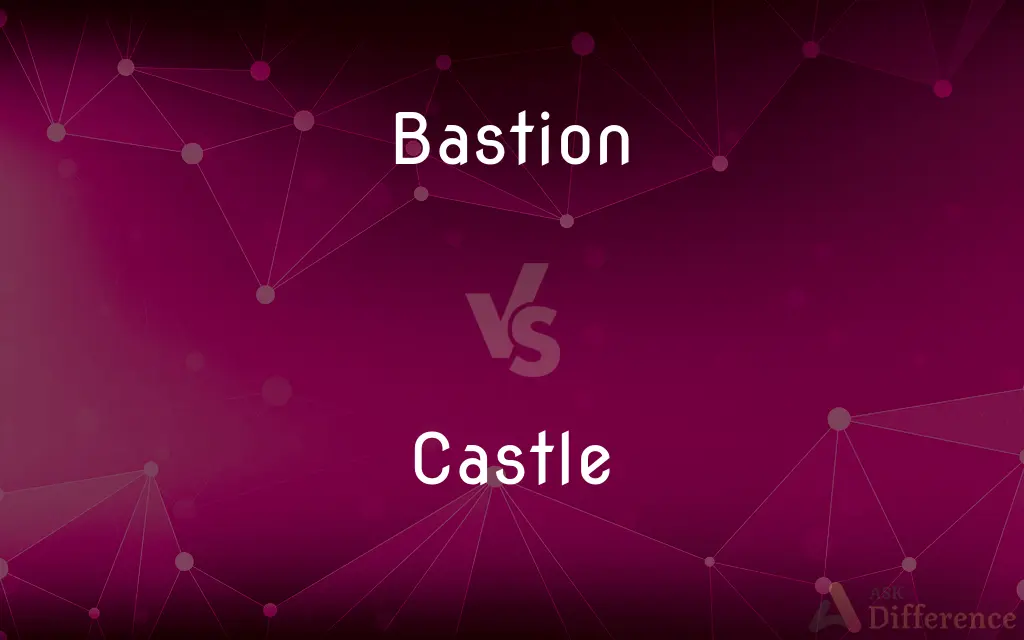Bastion vs. Castle — What's the Difference?
By Tayyaba Rehman & Maham Liaqat — Updated on March 28, 2024
A bastion is a fortification projecting outward from a defensive wall, designed for defensive combat, whereas a castle is a large fortified residence or complex of buildings, often the seat of a noble or royal.

Difference Between Bastion and Castle
Table of Contents
ADVERTISEMENT
Key Differences
Bastions are specific architectural elements within fortifications, characterized by their angular or curved structures projecting from a wall. Their primary purpose is defensive, allowing defenders to cover adjacent walls with gunfire or other projectiles. Castles, in contrast, serve as fortified residences, combining the functions of defense, administration, and living quarters. They are symbols of power and authority, often encompassing not just the living spaces but also courtyards, chapels, and defensive structures like towers and walls.
While bastions were developed during the gunpowder era to improve the defense of fortifications against artillery attacks, castles have medieval origins, designed to protect against sieges and serve as administrative and military centers. Bastions reflect advancements in military architecture, focusing on defense tactics incorporating artillery, whereas castles are more about a blend of military strength, noble residence, and symbolic power.
The strategic importance of bastions lies in their ability to provide enfilading fire, covering flanking angles and enhancing the fortification's defense against attackers. Castles, however, were often situated strategically on high ground or near key resources, not only for their military advantages but also to assert dominance and control over surrounding lands.
Bastions are part of larger fortification systems, integrated into city walls or fortresses to strengthen vulnerable points. Castles stand as independent structures, often surrounded by a moat, walls, and defensive towers, serving as the lord's home and the local seat of power. Their design includes architectural elements for daily living, ceremonial functions, and defense.
Despite these differences, both bastions and castles symbolize strength and were central to military strategy in their respective eras. Today, they stand as historical monuments, offering insights into the architectural and military history of their times.
ADVERTISEMENT
Comparison Chart
Definition
A projecting part of a fortification designed for defensive combat.
A large fortified residence or complex, often the seat of noble or royal power.
Purpose
Primarily defensive, improving enfilading fire along adjacent walls.
Serves as a residence, administrative center, and military stronghold.
Era
Gunpowder era, reflecting advancements in military architecture.
Medieval, symbolizing feudal power and authority.
Structure
Angular or curved projections integrated into fortification walls.
A complex of buildings with living quarters, defensive towers, and walls.
Significance
Enhances the defense of fortifications against attackers.
Strategic residence location, symbol of dominance and military strength.
Compare with Definitions
Bastion
Incorporates artillery usage.
Cannons mounted on the bastion provided covering fire along the wall.
Castle
Serves as a noble residence.
The castle was home to the region’s ruling family for centuries.
Bastion
Reflects advancements in military architecture.
The star-shaped bastion was an innovation that greatly improved defensive capabilities.
Castle
Includes living and administrative spaces.
The castle’s great hall was the center of political life and festivities.
Bastion
Designed for military defense.
The bastion was crucial in the city’s defense against the besieging forces.
Castle
Symbolizes power and authority.
Standing atop a hill, the castle dominated the surrounding landscape.
Bastion
Focuses on strategic combat advantages.
The bastion’s design allowed defenders to engage attackers from multiple angles.
Castle
Designed for medieval warfare.
The castle’s thick walls and towers were built to withstand long sieges.
Bastion
Part of fortification systems.
The fortress included several bastions to protect its vulnerable points.
Castle
Strategically located for defense and control.
Located at a river crossing, the castle controlled access to the region.
Bastion
A bastion or bulwark is a structure projecting outward from the curtain wall of a fortification, most commonly angular in shape and positioned at the corners of the fort. The fully developed bastion consists of two faces and two flanks, with fire from the flanks being able to protect the curtain wall and the adjacent bastions.
Castle
A castle is a type of fortified structure built during the Middle Ages predominantly by the nobility or royalty and by military orders. Scholars debate the scope of the word castle, but usually consider it to be the private fortified residence of a lord or noble.
Bastion
A projecting part of a fortification.
Castle
A large fortified building or group of buildings with thick walls, usually dominating the surrounding country.
Bastion
A well-fortified position.
Castle
A fortified stronghold converted to residential use.
Bastion
One that upholds or defends something, as against neglect or unpopularity
A college that is a bastion of traditionalism.
Castle
A large ornate building similar to or resembling a fortified stronghold.
Bastion
(architecture) A projecting part of a rampart or other fortification.
Castle
A place of privacy, security, or refuge.
Bastion
A well-fortified position; a stronghold or citadel.
Castle
(Games) See rook2.
Bastion
(figuratively) A person, group, or thing, that strongly defends some principle.
A bastion of hope
The bastion of democracy
Castle
To move the king in chess from its own square two empty squares to one side and then, in the same move, bring the rook from that side to the square immediately past the new position of the king.
Bastion
Any large prominence; something that resembles a bastion in size and form.
Castle
To place in or as if in a castle.
Bastion
(transitive) To furnish with a bastion.
Castle
(Games) To move (the king in chess) by castling.
Bastion
A work projecting outward from the main inclosure of a fortification, consisting of two faces and two flanks, and so constructed that it is able to defend by a flanking fire the adjacent curtain, or wall which extends from one bastion to another. Two adjacent bastions are connected by the curtain, which joins the flank of one with the adjacent flank of the other. The distance between the flanks of a bastion is called the gorge. A lunette is a detached bastion. See Ravelin.
Castle
A large residential building or compound that is fortified and contains many defences; in previous ages often inhabited by a nobleman or king. Also, a house or mansion with some of the architectural features of medieval castles.
Bastion
A group that defends a principle;
A bastion against corruption
The last bastion of communism
Castle
(chess) An instance of castling.
Bastion
A stronghold into which people could go for shelter during a battle
Castle
A rook; a chess piece shaped like a castle tower.
Bastion
Projecting part of a rampart or other fortification
Castle
(shogi) A defense structure in shogi formed by defensive pieces surrounding the king.
Castle
(obsolete) A close helmet.
Castle
(dated) Any strong, imposing, and stately palace or mansion.
Castle
(dated) A small tower, as on a ship, or an elephant's back.
Castle
The wicket.
Castle
(transitive) To house or keep in a castle.
Castle
To protect or separate in a similar way.
Castle
(obsolete) To make into a castle: to build in the form of a castle or add (real or imitation) battlements to an existing building.
Castle
To move the king 2 squares right or left and, in the same turn, the nearest rook to the far side of the king. The move now has special rules: the king cannot be in, go through, or end in check; the squares between the king and rook must be vacant; and neither piece may have been moved before castling.
Castle
To create a similar defensive position in Japanese chess through several moves.
Castle
(cricket) To bowl a batsman with a full-length ball or yorker such that the stumps are knocked over.
Castle
A fortified residence, especially that of a prince or nobleman; a fortress.
The house of every one is to him castle and fortress, as well for his defense againts injury and violence, as for his repose.
Our castle's strengthWill laugh a siege to scorn.
Castle
Any strong, imposing, and stately mansion.
Castle
A small tower, as on a ship, or an elephant's back.
Castle
A piece, made to represent a castle, used in the game of chess; a rook.
Castle
To move the castle to the square next to king, and then the king around the castle to the square next beyond it, for the purpose of covering the king.
Castle
A large and stately mansion
Castle
A large building formerly occupied by a ruler and fortified against attack
Castle
(chess) the piece that can move any number of unoccupied squares in a direction parallel to the sides of the chessboard
Castle
Interchanging the positions of the king and a rook
Castle
Move the king two squares toward a rook and in the same move the rook to the square next past the king
Common Curiosities
Can a castle have bastions?
Yes, castles built or modified during the gunpowder era might include bastions as part of their defensive structures.
What is the historical significance of castles?
Castles are historically significant as symbols of feudal power, military strength, and architectural innovation, often serving as administrative and residential centers.
What role did geography play in the location of castles?
Geography was crucial, with castles often located in strategic positions to control territory, resources, and access routes, maximizing defensive advantages.
Why were bastions developed?
Bastions were developed to adapt fortifications to the use of gunpowder artillery, enhancing defensive capabilities against such attacks.
How did the purpose of bastions affect their design?
The purpose of enhancing defense against artillery attacks influenced bastions to have angular or curved designs, allowing for enfilading fire and better protection.
What distinguishes a bastion from a castle?
A bastion is a defensive projection in fortifications, focusing on military defense, while a castle is a fortified residence, symbolizing power and serving multiple functions.
How has the use of bastions and castles evolved over time?
While their military use has declined with advances in warfare technology, many bastions and castles have been preserved as historical or cultural sites.
Were castles only used for military purposes?
No, castles also served as noble residences, administrative centers, and symbols of social status and power.
What era are bastions most associated with?
Bastions are most associated with the gunpowder era, reflecting changes in military architecture due to advancements in artillery.
Are there modern equivalents to bastions and castles?
Modern military fortifications and secure residences reflect the defensive principles of bastions and castles, though with advancements in technology and different societal structures.
Share Your Discovery

Previous Comparison
Bout vs. Round
Next Comparison
Minisatellite vs. MicrosatelliteAuthor Spotlight
Written by
Tayyaba RehmanTayyaba Rehman is a distinguished writer, currently serving as a primary contributor to askdifference.com. As a researcher in semantics and etymology, Tayyaba's passion for the complexity of languages and their distinctions has found a perfect home on the platform. Tayyaba delves into the intricacies of language, distinguishing between commonly confused words and phrases, thereby providing clarity for readers worldwide.
Co-written by
Maham Liaqat














































